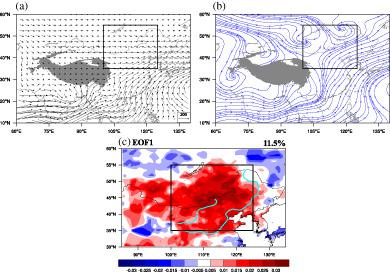当前位置:
X-MOL 学术
›
Int. J. Climatol.
›
论文详情
Our official English website, www.x-mol.net, welcomes your
feedback! (Note: you will need to create a separate account there.)
The modulation of westerlies‐monsoon interaction on climate over the monsoon boundary zone in East Asia
International Journal of Climatology ( IF 3.5 ) Pub Date : 2020-10-23 , DOI: 10.1002/joc.6903 Jie Chen 1 , Wei Huang 1 , Song Feng 2 , Qiong Zhang 3 , Xueyuan Kuang 4 , Jianhui Chen 1 , Fahu Chen 1, 5, 6
International Journal of Climatology ( IF 3.5 ) Pub Date : 2020-10-23 , DOI: 10.1002/joc.6903 Jie Chen 1 , Wei Huang 1 , Song Feng 2 , Qiong Zhang 3 , Xueyuan Kuang 4 , Jianhui Chen 1 , Fahu Chen 1, 5, 6
Affiliation

|
Monsoon boundary zone (MBZ) is a transitional zone between the arid Central Asia (ACA) and humid Asia monsoon area, located in North China‐Mongolia. During boreal summer, both the mid‐latitude westerlies and East Asian Summer monsoon (EASM) play essential roles in the precipitation variations in the MBZ, via causing anomalous cold air mass from the west and warm/humid air from the south to the MBZ. In this study, we defined a summer westerly index (SWI) over the key westerly domain (35°‐42.5°N, 80°‐100°E) and an EASM index (EASMI) over the key EASM domain (25°‐35°N, 107.5°‐125°E) to investigate westerlies‐monsoon interaction and their effect on MBZ climate. The results show that westerlies and EASM have a synergistic effect on the precipitation in the MBZ and this synergistic effect could be amplified by the westerlies‐monsoon interaction. The westerlies and EASM interaction could induce a local cyclonic anomaly in the MBZ, this cyclonic anomaly further intensifies the westerlies and monsoon flow through a dynamical amplification, favours the precipitation in the MBZ. The MBZ precipitation also contributes to maintain the cyclonic anomaly via the latent heating release. The interannual variability of westerlies is largely modulated by the mid‐latitude Silk Road pattern (SRP) and the meridional displacement of the Asian westerly jet (AWJ), and the EASM variability is mainly modulated by El Niño‐Southern Oscillation (ENSO), the combined effects from these mid‐latitude circulation systems and tropical SST contribute to the climate variability in MBZ.
中文翻译:

西亚季风相互作用对东亚季风边界带气候的调节
季风边界带(MBZ)是介于干旱的中亚(ACA)和湿润的亚洲季风区域之间的过渡区域,位于华北-蒙古。在北方夏季,中纬度西风和东亚夏季风(EASM)在MBZ的降水变化中起着重要作用,它们引起了西方异常的冷空气团和南方到MBZ的暖湿空气。在本研究中,我们定义了关键西风域(35°-42.5°N,80°-100°E)的夏季西风指数(SWI)和关键EASM域(25°-35)的EASM指数(EASMI) °N,107.5°-125°E)以研究西风-季风之间的相互作用及其对MBZ气候的影响。结果表明,西风和EASM对MBZ中的降水具有协同作用,而这种协同作用可通过西风与季风之间的相互作用来放大。西风和EASM相互作用可能在MBZ中引起局部气旋异常,这种旋风异常通过动态放大进一步加剧了西风和季风流,有利于MBZ中的降水。MBZ沉淀还通过潜热释放来维持旋风异常。西风的年际变化主要受中纬度丝路模式(SRP)和亚洲西风急流(AWJ)的子午位移的影响,而EASM的变化主要受厄尔尼诺—南方涛动(ENSO)的影响。这些中纬度环流系统和热带海温的综合作用导致了MBZ的气候变化。这种气旋异常通过动态放大进一步加剧了西风和季风,有利于MBZ中的降水。MBZ沉淀还通过潜热释放来维持旋风异常。西风的年际变化主要受中纬度丝路模式(SRP)和亚洲西风急流(AWJ)的子午位移的影响,而EASM的变化主要受厄尔尼诺—南方涛动(ENSO)的影响。这些中纬度环流系统和热带海温的综合作用导致了MBZ的气候变化。这种气旋异常通过动态放大进一步加剧了西风和季风,有利于MBZ中的降水。MBZ沉淀还通过潜热释放来维持旋风异常。西风的年际变化主要受中纬度丝路模式(SRP)和亚洲西风急流(AWJ)的子午位移的影响,而EASM的变化主要受厄尔尼诺—南方涛动(ENSO)的影响。这些中纬度环流系统和热带海温的综合作用导致了MBZ的气候变化。
更新日期:2020-10-23
中文翻译:

西亚季风相互作用对东亚季风边界带气候的调节
季风边界带(MBZ)是介于干旱的中亚(ACA)和湿润的亚洲季风区域之间的过渡区域,位于华北-蒙古。在北方夏季,中纬度西风和东亚夏季风(EASM)在MBZ的降水变化中起着重要作用,它们引起了西方异常的冷空气团和南方到MBZ的暖湿空气。在本研究中,我们定义了关键西风域(35°-42.5°N,80°-100°E)的夏季西风指数(SWI)和关键EASM域(25°-35)的EASM指数(EASMI) °N,107.5°-125°E)以研究西风-季风之间的相互作用及其对MBZ气候的影响。结果表明,西风和EASM对MBZ中的降水具有协同作用,而这种协同作用可通过西风与季风之间的相互作用来放大。西风和EASM相互作用可能在MBZ中引起局部气旋异常,这种旋风异常通过动态放大进一步加剧了西风和季风流,有利于MBZ中的降水。MBZ沉淀还通过潜热释放来维持旋风异常。西风的年际变化主要受中纬度丝路模式(SRP)和亚洲西风急流(AWJ)的子午位移的影响,而EASM的变化主要受厄尔尼诺—南方涛动(ENSO)的影响。这些中纬度环流系统和热带海温的综合作用导致了MBZ的气候变化。这种气旋异常通过动态放大进一步加剧了西风和季风,有利于MBZ中的降水。MBZ沉淀还通过潜热释放来维持旋风异常。西风的年际变化主要受中纬度丝路模式(SRP)和亚洲西风急流(AWJ)的子午位移的影响,而EASM的变化主要受厄尔尼诺—南方涛动(ENSO)的影响。这些中纬度环流系统和热带海温的综合作用导致了MBZ的气候变化。这种气旋异常通过动态放大进一步加剧了西风和季风,有利于MBZ中的降水。MBZ沉淀还通过潜热释放来维持旋风异常。西风的年际变化主要受中纬度丝路模式(SRP)和亚洲西风急流(AWJ)的子午位移的影响,而EASM的变化主要受厄尔尼诺—南方涛动(ENSO)的影响。这些中纬度环流系统和热带海温的综合作用导致了MBZ的气候变化。









































 京公网安备 11010802027423号
京公网安备 11010802027423号